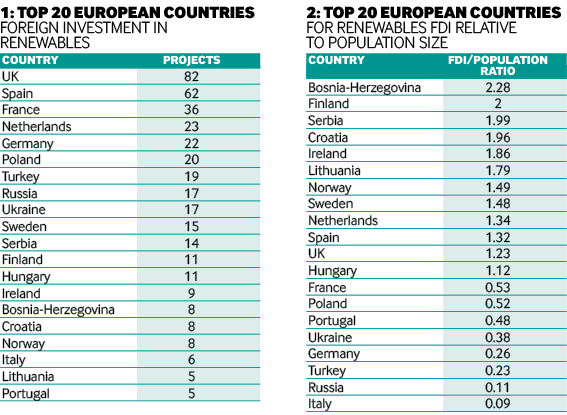Europe was the world’s top region for foreign investment in renewable energy projects in 2019, according to greenfield investment monitor fDi Markets.
Last year also witnessed an eight-year high in renewable energy FDI to Europe, following a significant drop in investment since 2013, due mainly to reduced feed-in tariff policies that offer financial incentives to green energy producers.
Advertisement
Download a PDF of this ranking here:
However, Europe's green energy market – especially in solar – is undergoing a renaissance, thanks to an increase in the number of utility scale auctions, feed-in tariffs and subsidy-free deployment.
According to the EU Market Outlook, 2019 was one of the best years on record for the continent’s solar industry.
UK utilises wind
The UK is Europe's leading destination for foreign investment in renewable energy, attracting more greenfield projects (in electricity production or business operations) than any other country in the region between January 2016 and December 2019, according to fDi’s Top European Locations for Renewable Energy Investment ranking, which is based on fDi Markets data.
In this period, most foreign investment to the UK went to wind energy, followed by biomass power. In mid-2019, Germany’s Innogy SE announced plans to develop a record-breaking £3bn ($3.72bn) wind farm off the north-east coast of the UK. The 1.4-gigawatt Sofia project will power about 1.2 million homes, through one of the world’s longest offshore cable routes.
Advertisement
The UK has implemented an ambitious and well-incentivised strategy to install 30 gigawatts of offshore renewables by 2030, with a planned investment of £48bn in offshore wind infrastructure, according to ORE Catapult.
Spain shines in the sun
Spain is Europe’s second top destination for foreign investment in renewable energy, according to fDi’s ranking. It is no surprise that the majority of FDI projects in Spanish renewables have been in solar energy. After years of policy-induced weakness, which led to very limited foreign investment in Spanish renewables, the country is now one of Europe’s hottest solar markets.
Early in 2020, construction was completed on the Núñez de Balboa solar power project, which covers an area equivalent to 1200 soccer pitches and is the largest of its kind in Europe, according to the World Economic Forum.
Spain also has companies such Heineken España that turn the remains from olive grove pruning into biofuel thermal energy, thereby powering some of the country’s Heineken breweries.
France is in third place in fDi’s ranking. Like Spain, the French government has an ambitious climate-change agenda, including strong incentives for foreign investment. One of the country's most recent arrivals is Belgium-based WindVision, which announced plans to establish a new 390-megawatt wind farm in a €532.5m project that will provide electricity to about 250,000 people.
fDi’s Top European Locations for Renewable Energy Investment also ranks Europe’s leading countries for FDI in renewables relative to their population size. Based on this, Bosnia-Herzegovina takes first place, followed by Finland and Serbia.
Global appetite
The wave of foreign investment in European renewables is part of a wider trend. Indeed, the global renewable energy market is also experiencing a boom, with 2019 registering an unprecedented number of FDI projects, according to fDi Markets.
“Investor appetite for clean energy projects is at an all-time high, and far outstrips supply. This is because clean energy projects typically offer at least some level of revenue, certainty through power purchasing agreements or government support schemes,” says Dario Traum, Europe, Middle East and north Africa head of policy at BloombergNEF.
“The increased focus on environmental, social and corporate governance-compliant investment of large investors, combined with corporate sustainability pledges, and the continued decline of clean energy technologies, is supporting activity around the globe,” he adds.
That said, over the past three years, global investment in renewable energy (beyond greenfield FDI) has decreased. Global investment in the market peaked in 2017 at $326.3bn, but then fell by 11.5% in 2018, according to BloombergNEF. Meanwhile, global investment in renewable energy fell by 14% in the first half of 2019, compared with the same period the year before.
However, research from the World Economic Forum says: “The slower growth in renewable energy investment can be attributed mainly to falling costs in solar and wind globally, and to the change in market conditions with reduced subsidies in many countries.”
This article first appeared in the April-June edition of fDi Magazine.
